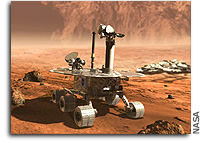NASA Mars Exploration Rover Mission Status 6 Aug 2003

The first in-flight checkouts of the science instruments and
engineering cameras on NASA’s twin Spirit and Opportunity spacecraft
on their way to Mars have provided an assessment of the instruments’
condition after the stressful vibrations of launch.
The instrument tests run by the Mars Exploration Rover flight team at
NASA’s Jet Propulsion Laboratory, Pasadena, Calif., finished with
performance data received Tuesday from two of the spectrometers on
Opportunity.
Each rover’s suite of science instruments includes a stereo panoramic
camera pair, a microscope camera and three spectrometers. The tests
also evaluated performance of each spacecraft’s engineering cameras,
which are a stereo navigation camera pair, stereo hazard-avoidance
camera pairs on the front and back of the rover, and a
downward-pointing descent camera on the lander to aid a system for
reducing horizontal motion just before impact.
All 10 cameras on each spacecraft – three science cameras and seven
engineering cameras on each – performed well. One of the three
spectrometers on Spirit returned data that did not fit the expected
pattern. The other two spectrometers on Spirit and all three on
Opportunity worked properly. Teams have been busy since the tests
began nearly three weeks ago analyzing about 200 megabits of
instrument data generated from each spacecraft.
"All the engineering cameras are healthy," said JPL imaging scientist
Dr. Justin Maki. "We took two pictures with each engineering camera —
14 pictures from each spacecraft. Even when the cameras are in the
dark, the images give characteristic signatures that let us know
whether the electronics are working correctly."
The science cameras on each rover – the Pancam color panoramic cameras
and the Microscopic Imagers – all performed flawlessly. A spectrometer
on each rover for identifying minerals from a distance, called the
miniature thermal emission spectrometer, or mini-TES, also worked
perfectly on each rover.
Two other spectrometers – an alpha particle X-ray spectrometer and a
Mˆssbauer spectrometer – are mounted on an extendable arm for close-up
examination of the composition of rocks and soil. Both instruments on
Opportunity, as well as Spirit’s alpha particle X-ray spectrometer
worked properly. The Mˆssbauer spectrometer on Spirit is the one
whose test data did not fit the pattern expected from normal
operation.
"The Mˆssbauer results we just received from Opportunity are helping
us interpret the data that we’ve been analyzing from Spirit," said Dr.
Steve Squyres of Cornell University, Ithaca, N.Y., principal
investigator for the suite of science tools on each rover. "Some of
the theories we had developed for what might be causing the anomalous
behavior of the Mˆssbauer instrument on Spirit have been eliminated by
looking at the data from the one on Opportunity."
The remaining theories focus on an apparent problem in movement of a
mechanism within the instrument that rapidly vibrates a gamma-ray
source back and forth.
"The Mˆssbauer spectrometer on Spirit is working, and even if we don’t
come up with a way to improve its performance, we’ll be able to get
scientific information out of the data it sends us from Mars," Squyres
said. "But it’s a very flexible instrument, with lots of parameters we
can change. We have high hopes that over the coming months we’ll be
able to understand exactly what’s happened to it and make adjustments
that will improve its performance. And if the Mˆssbauer spectrometer
on Opportunity behaves on Mars the way it did today, we’ll get
beautiful data from that instrument."
The two types of spectrometers on the rovers’ extendable arms
complement each other. The alpha particle X-ray spectrometers provide
information about what elements are in a rock. The Mˆssbauer
spectrometers give information about the arrangement of iron atoms in
the crystalline mineral structure within a rock.
As of 6 a.m. Pacific Daylight Time August 7, Spirit will have traveled
157.1 million kilometers (97.6 million miles) since its June 10
launch, and Opportunity will have traveled 82.7 million kilometers
(51.4 million miles) since its July 7 launch. After arrival, the
rovers will examine their landing areas for geological evidence about
the history of water on Mars.
JPL, a division of the California Institute of Technology, manages the
Mars Exploration Rover project for NASA’s Office of Space Science,
Washington, D.C. Additional information about the project is
available from JPL at
and from Cornell University, Ithaca, N.Y., at








